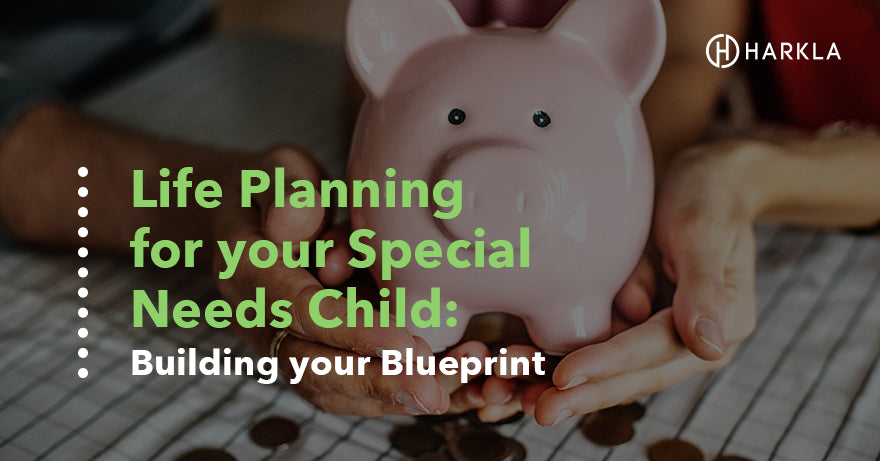Your Cart is Empty

The circumstances that separate parents of a special needs child and parents of neurotypical children can be a long list.
Diets, various therapies, educational needs, IEP’s and 504’s, specialist after specialist after specialist. But what keeps us up late at night?

When the day is “done,” our beautifully perfect (yet societally imperfect) children sleep, and the time to exhale allows us to ponder the ultimate question: What will happen to my child when I am gone? Where will they live? Who will do all the things I do for him/her? Will he/she be happy & healthy? Do we have funds to provide for the long-term?
We may answer one or two of these, maybe even have a conversation with a loved one, but inevitably we get lost in our ever-consuming-day-to-day tasks taking care of our child and unintentionally avoid properly addressing our deepest concerns.
This article is the first of our series that will help give the parents of a special needs child a step-by-step guide to easing their fears. I can not lie, it is a daunting task. As someone once told me, it is like eating an elephant…one bite at a time (which I’d never do, by the way, I LOVE ELEPHANTS).
PLEASE KEEP THIS IN MIND: It is never too soon to start planning, plans can be revised, and you are not alone.
With that, let’s get started with the first BITE.
A major misconception in the realm of special needs planning is that a family can sufficiently plan and provide for the needs of their child with just a will and a trust.
Let’s take a moment to define those two items for clarification, as defined by Merriam Webster Dictionary:
A will is a legal declaration of a person's wishes regarding the disposal of his or her property or estate after death, especially, a written instrument legally executed by which a person makes disposition of his or her estate to take effect after death.
A Trust is a documented agreement assigning a Trustee or multiple Trustees to oversee property management for the benefit of persons or institutions for which the trust was created.
Generally speaking, there are two kinds of trust: Revocable and Irrevocable, but we can dive deeper from there. For now, let’s just acknowledge the fact those tools are exceptionally important in long term estate planning needs, but they do not address the daily living needs of our children. We will discuss in-depth the Special Needs Trust and the different funding types to be established.

The first step in properly addressing the entirety of need is creating the “Life Plan.” This is not a formal, legal document, but rather a work-in-progress created by you, your family and, if possible, the child the plan is addressing.
This will be your “blueprint” for creating the more formal Letter of Intent that is shared with your trusted friends, relatives, and your team. I usually recommend a legal pad or laptop, block out some time after dinner and bedtime with your partner, and start with these key concerns. List 3-4 items under each topic.
You could always add more to this as needed based upon your circumstances, but the point of this list is to get you started. Again, it is a daunting task that requires time and consideration but will help you in defining your goals.
Ask your child their dreams, desires, who they would want to live with (applicable in certain situations... again, you know your child better than anyone!). Once you’ve got this list you are ready to turn it into a more formal (although NOT LEGALLY binding) document, the Letter of Intent.
Many times a successor guardian/caregiver is a family member, but unless that caregiver has lived in the home with the child even that person does not know the ins-and-outs of daily living to which you’ve grown accustomed.
These family members do not know the names, phone numbers, email addresses, and locations of every service provider or practitioner. They may not be familiar with the exact diagnosis of your child, or the nuances that come with those diagnoses.

The purpose of the Letter of Intent is to communicate every detail to caregivers of your child after your death or incapacitation. Using the information you gathered in the Life Plan, the Letter of Intent will drill down into very prioritized, specific information for the life of your child.
This is not a legally binding document, but it is an “instruction manual” so-to-speak for giving your child a meaningful life, so be sure to write or type in an organized and clear manner.
Do not leave anything to chance, be specific when listing important data like birthdates, social security numbers, account numbers, etc. You will follow the “map” you set out in the Life Plan regarding education, residence, socialization, medical care, final arrangements for your child, as well as financial matters.
We will drill down into financial issues in coming articles, but for now, do your best with what you have. You can enter any information you deem important, but the following is a guideline format.
Family Information/History: Parents’ birthplaces, marriages, divorces, addresses. Child’s identifiers, siblings, extended family, and close family friends
General Overview: Introduce your relationship with your child and his/her personality traits; explain “why” you are creating this document. Note your dreams and goals, as well as those of your child. This is where you show emotion and color the most.
Medical History: List doctors and specialists. Include diagnoses, dates, and contact info. Note any surgeries in the past, any routine procedures that are currently performed, where, by who, and why.
Dietary Needs: Likes & dislikes; allergies, sensitivities & intolerances. Does your child hate the texture of carrots, for example? Do they have a strict gluten-free diet? What is the outcome if restricted foods are consumed?
Daily Schedule & Living: Be specific. From the moment of waking until bedtime routine and sleeping. How much assistance does your child require for daily living activities like toileting, dressing, feeding? Don’t forget self-care. Where does your child get haircuts? Does he/she enjoy it? How do you prepare the child if they do not like it? Are they able to groom themselves independently?
Education: Give historical information pertinent to the current educational environment, include recent IEP and all contacts for advocates, school administrators, etc. Explain your desires for future educational needs, as well.
Benefits: Social security, supplemental social security, disability. Is your child currently receiving or do you have intentions for them to receive food stamps, Medicaid, housing support? We will dive deeper into this topic in future articles.
Employment: Does your child work now? What would you like your child’s future employment to be? Has your child expressed an interest to you? Will it be a sheltered workshop, employment with supervision, an activity center? List any contacts or organizations you are connected with or know will assist the transition into employment (educational planning within public schools requires transition planning to begin at age 16)
Residential: Are the caregivers to stay in your home? How will the cost be covered? Does your child have interest and ability to live independently or in a group home? Roommates or an individual room? Location is important, as well, in relation to schools and social activities. What are your hopes for their future? List any information related to current living status and what you want the future to be.
Social & Religious: What activities does your child enjoy participating in or watching? Swimming, hiking, library, amusement parks, etc. What are any physical limitations that the caregiver needs to be aware of? Where is their favorite place to go? Where do you worship? Does your child enjoy sitting up front or the back during worship? Does music or singing affect your child negatively or positively? Location and transportation are vitally important, too. Is there a private bus/van for these activities or church? Does your child take public transport alone? List any contacts related to social and religious activities as well as transportation.
Behavior Management: Be as detailed as possible! What “triggers” affect your child negatively and positively? For instance, my child LOVES the band Twenty-one Pilots, except for one single song. He throws the Bluetooth speaker and hides until either the song ends or we change it. He is non-verbal, so one would have to be familiar with him to understand why he behaves in that manner.
How do you soothe the child in a negative/tense situation? What techniques/interventions work best? What makes them excited? What indicators should a caregiver look for to understand the mood of the child? Again list contact info for any specialists or therapists.
Final Arrangements: Is there life insurance or funeral insurance in place for your child? List your plans in place with funeral homes, places of worship, monuments, crematory, etc. If none, list your core beliefs and wishes for such plans.
Other: Note any pertinent information not otherwise covered in the previous areas.
Parents of special needs children do not live daily life as parents of neurotypical children do, and our future planning needs are much more complex. However, YOU ARE NOT ALONE!
There are many many resources available to us. The internet is our friend! The public library is our friend! Social media groups are our friends! Do not be afraid to ask questions and join discussions.
In our future articles, we will cover more details around benefits and services, education planning, special needs trusts, and the importance of building a team you can rely on.
Comments will be approved before showing up.


Jennifer Schreiner
January 27, 2021
Thank you Jacqueline for this great information and helping start this big procedure in small steps. It would help to have some sort of example to view and get idea for formats. Do you have any available?
Thank you again, Jennifer S.